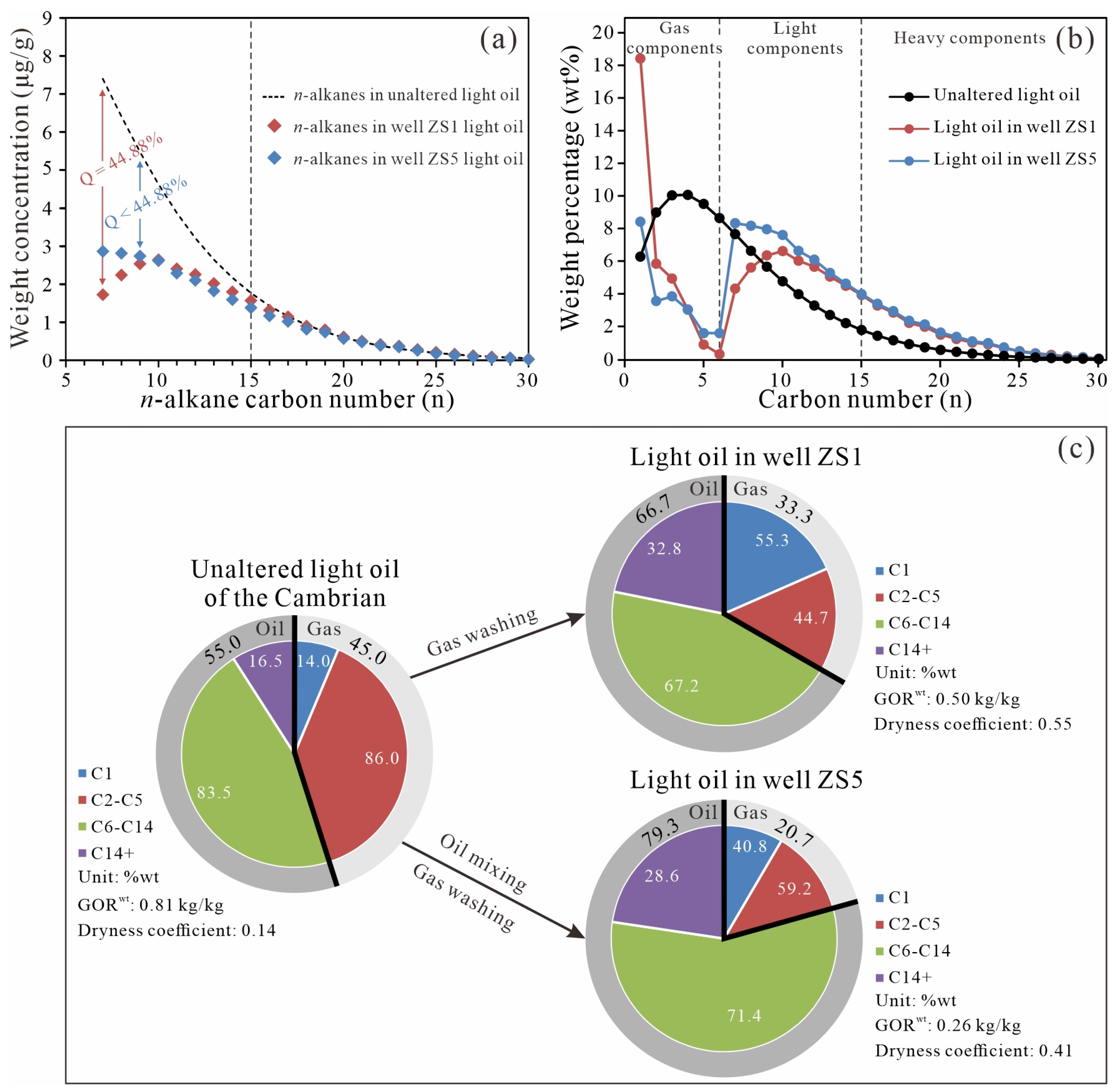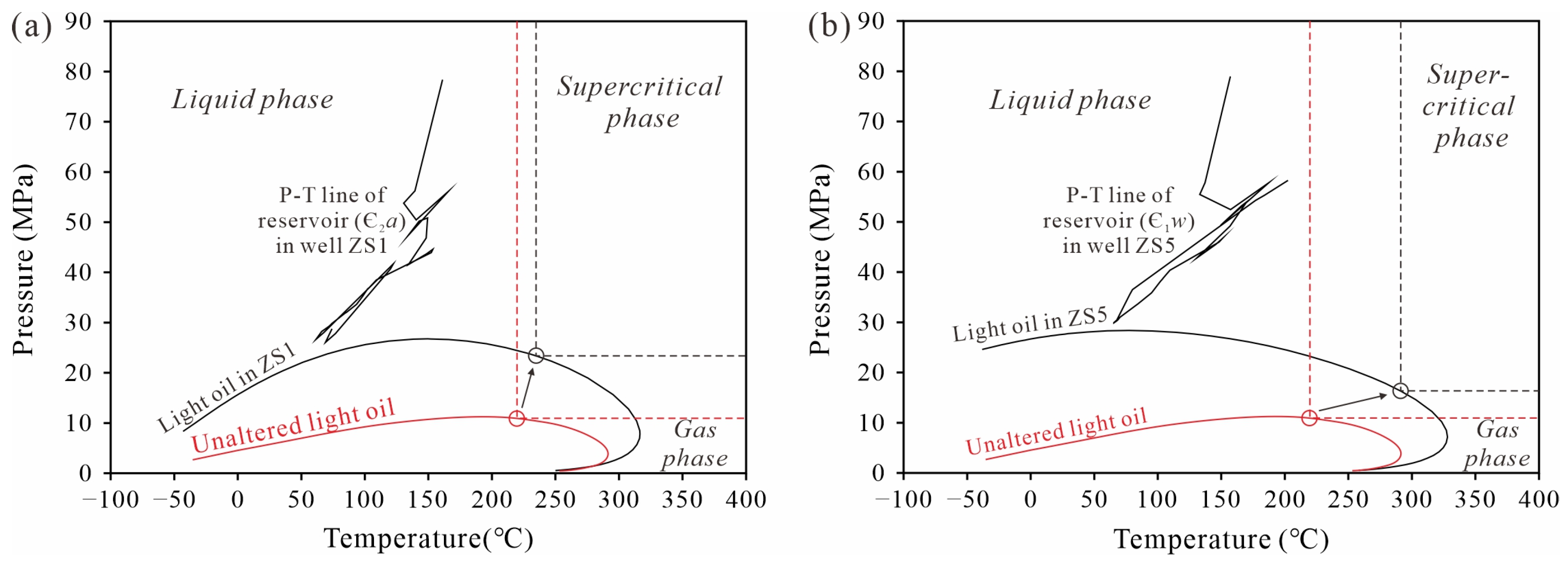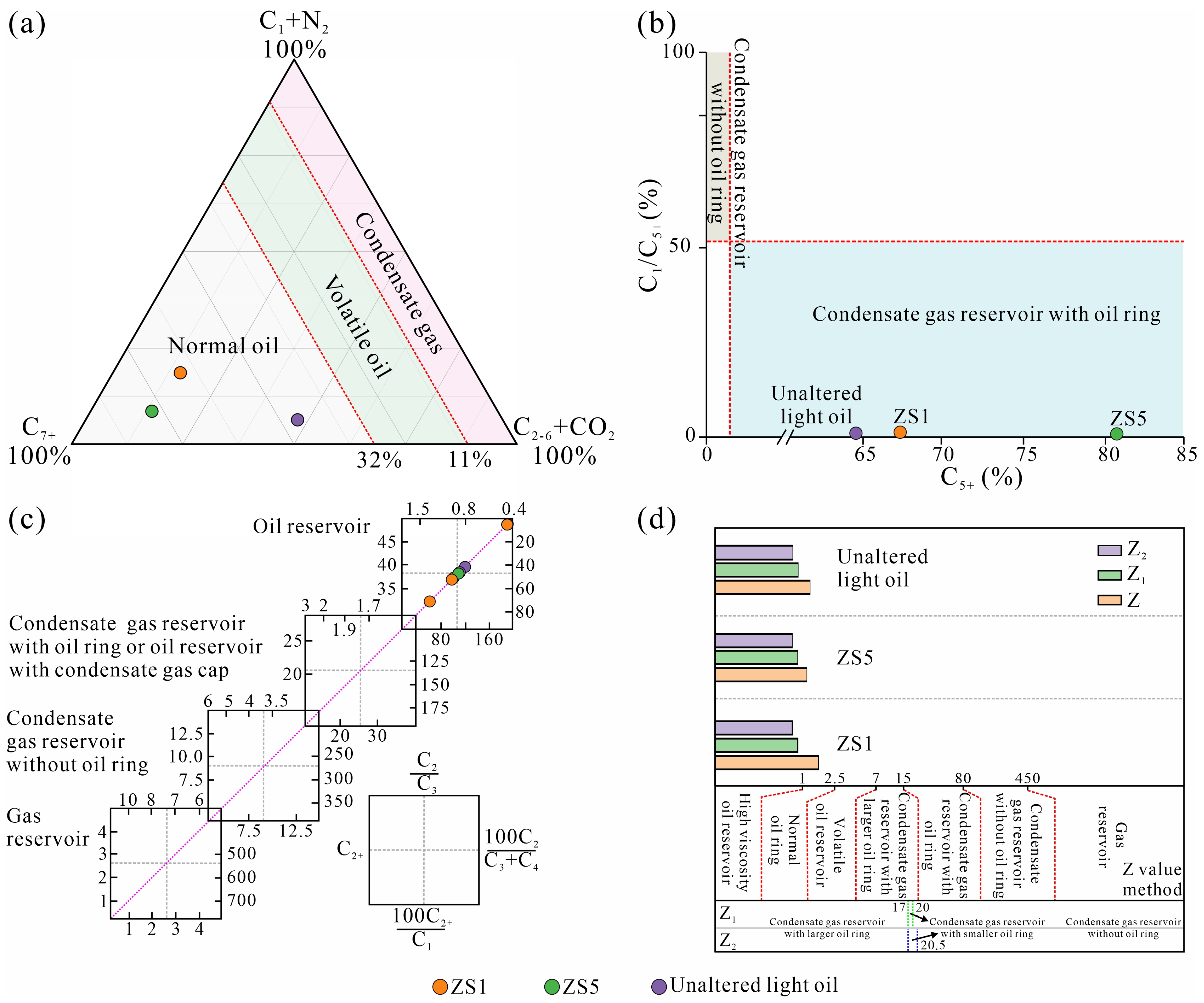Influence of Gas Washing and Oil Mixing on the Phase Behavior and Physical Properties of Cambrian Light Oils in the Tazhong Uplift, Tarim Basin
Abstract
1. Introduction
2. Geological Setting
3. Methods and Data
3.1. Samples and Experiments
3.2. Quantitative Assessment of Gas Washing and Oil Mixing
3.3. Quantitative Calculations and Numerical Simulations
4. Results
4.1. Relationship Between Molar Concentration and Carbon Number of n-Alkanes
4.2. Gas-Washing Intensity (Q Value)
4.3. Hydrocarbon Composition of Unaltered and Altered Light Oils
4.4. Phase Behavior of Light Oils Under Gas Washing and Oil Mixing
4.5. Historical Evolution of Phase and Physical Properties
5. Discussion
5.1. Source and Preservation of Light Oil
5.2. Geochemical Evidence of Gas Washing and Oil Mixing
5.3. Controlling Factors of Gas Washing Fractionation
6. Conclusions
- The gas washing in well ZS1 was more intensive than in well ZS5. Gas washing strongly altered the light oils in the Cambrian subsaltic dolomite reservoirs, although the intensity varied in the different wells. The Q value in well ZS1 (Є2a) was calculated to be 40.88%, indicating an intermediate intensity of gas washing. This intensity was lower in well ZS5 (Є1w) (Q value < 40.88%) and highest in well ZS1C (Є1x), where the gas washing approached 100%. These results confirm that gas washing is more widespread in the Cambrian reservoirs than previously thought.
- Oil was mixed in well ZS5. Obvious oil mixing was identified in well ZS5, where the presence of light oils and remnants of normal oils indicates historical mixing. This observation suggests that normal oils may have accumulated sporadically in the Cambrian reservoirs prior to the accumulation of light oil.
- The hydrocarbon composition was changed by gas washing and oil mixing. Gas washing and oil mixing significantly influenced the hydrocarbon composition, physical properties, and phase behavior of light oils. Compared to the unaltered light oil, the GOR, dryness coefficient, and hydrocarbon composition of wells ZS1 and ZS5 were altered by gas washing and oil mixing. However, despite these changes, the light oils in the Cambrian reservoirs remained in a single liquid-phase state throughout their history, without transitioning to condensate or gas phases.
- The phase behavior and physical properties fluctuated by gas washing and mixing. While the gas washing and mixing of the oil changed the hydrocarbon composition, light oils retained their liquid-phase state under deep reservoir conditions. This consistency of phase behavior supports the long-term preservation of these oils in Cambrian reservoirs, which is confirmed by the dry gas reservoir in well ZS1C.
- The intensity of gas washing was controlled by several factors, including the depth of the reservoir, proximity to deep faults, and distance from the gas source. Wells closer to the gas source or at greater depth, such as ZS1 and ZS1C, experienced stronger gas washing than wells like ZS5, which was further away from the source.
Author Contributions
Funding
Data Availability Statement
Acknowledgments
Conflicts of Interest
References
- Thompson, K.F.M. Fractionated Aromatic Petroleums and the Generation of Gas-Condensates. Org. Geochem. 1987, 11, 573–590. [Google Scholar] [CrossRef]
- Yang, C.; Geng, A.; Liao, Z.; Sun, Y.; Zhang, L. Quantitative Assessment of Gas Washing of Oils in the Tazhong Area of the Tarim Basin, Northwest China. Sci. China Ser. D Earth Sci. 2009, 52, 12–21. [Google Scholar] [CrossRef]
- Losh, S.; Cathles, L. Phase Fractionation and Oil-Condensate Mass Balance in the South Marsh Island Block 208–239 Area, Offshore Louisiana. Mar. Pet. Geol. 2010, 27, 467–475. [Google Scholar] [CrossRef]
- Deng, R.; Chen, C.; Shi, S.; Wang, Y. Fluid Phase Simulation and Evolution of a Condensate Gas Reservoir in the Tazhong Uplift, Tarim Basin. Geofluids 2019, 2019, 8627698. [Google Scholar] [CrossRef]
- Meulbroek, P.; Cathles, L.; Whelan, J. Phase Fractionation at South Eugene Island Block 330. Org. Geochem. 1998, 29, 223–239. [Google Scholar] [CrossRef]
- Losh, S.; Cathles, L.; Meulbroek, P. Gas Washing of Oil along a Regional Transect, Offshore Louisiana. Org. Geochem. 2002, 33, 655–663. [Google Scholar] [CrossRef]
- Chen, C.; Wang, Y.; Beagle, J.R.; Liao, L.; Shi, S.; Deng, R. Reconstruction of the Evolution of Deep Fluids in Light Oil Reservoirs in the Central Tarim Basin by Using PVT Simulation and Basin Modeling. Mar. Pet. Geol. 2019, 107, 116–126. [Google Scholar] [CrossRef]
- Xiao, Z.; Su, J.; Yang, H.; Wang, Y.; Huang, S.; Huang, L.; Zhang, B.; Weng, N.; Lu, Y.; Zhang, K. The Genesis and Prospecting Significance of High-Sulfur Gas Condensates in the Deep Dolomite Reservoirs Beneath Gypsum Rocks: A Case Study of the Cambrian Reservoir in Tarim Basin. Pet. Sci. Technol. 2015, 33, 1643–1652. [Google Scholar] [CrossRef]
- Huang, H.; Zhang, S.; Su, J. Palaeozoic Oil–Source Correlation in the Tarim Basin, NW China: A Review. Org. Geochem. 2016, 94, 32–46. [Google Scholar] [CrossRef]
- Song, D.; Wang, T.; Li, M. Geochemistry and Possible Origin of the Hydrocarbons from Wells Zhongshen1 and Zhongshen1C, Tazhong Uplift. Sci. China Earth Sci. 2015, 59, 840–850. [Google Scholar] [CrossRef]
- Zhu, G.; Huang, H.; Wang, H. Geochemical Significance of Discovery in Cambrian Reservoirs at Well ZS1 of the Tarim Basin, Northwest China. Energy Fuels 2015, 29, 1332–1344. [Google Scholar] [CrossRef]
- Chen, C.; Zhang, H.; Wang, Y.; Liao, L.; Shi, S.; Deng, R. Porosity Modeling of Huge Thick Carbonates: A Case Study of Lower Paleozoic Carbonates in the Tazhong Uplift, Tarim Basin, China. J. Energy Eng. 2021, 147, 04021045. [Google Scholar] [CrossRef]
- Zhang, S.; Huang, H.; Xiao, Z.; Liang, D. Geochemistry of Palaeozoic Marine Petroleum from the Tarim Basin, NW China. Part 2: Maturity Assessment. Org. Geochem. 2005, 36, 1215–1225. [Google Scholar] [CrossRef]
- Kissin, Y.V. Catagenesis and Composition of Petroleum: Origin of n-Alkanes and Isoalkanes in Petroleum Crudes. Geochim. Cosmochim. Acta 1987, 51, 2445–2457. [Google Scholar] [CrossRef]
- Xu, B.; Lei, Y.; Zhang, L.; Li, C.; Wang, J.; Zeng, Z.; Li, S.; Cheng, M.; Zhang, Z.; Xie, J. Hydrocarbon Phase State Evolution and Accumulation Process of Ultradeep Permian Reservoirs in Shawan Sag, Junggar Basin, NW China. Energy Fuels 2023, 37, 12762–12775. [Google Scholar] [CrossRef]
- Cai, C.; Zhang, C.; Worden, R.H.; Wang, T.; Li, H.; Jiang, L.; Huang, S.; Zhang, B. Application of Sulfur and Carbon Isotopes to Oil–Source Rock Correlation: A Case Study from the Tazhong Area, Tarim Basin, China. Org. Geochem. 2015, 83–84, 140–152. [Google Scholar] [CrossRef]
- Zhang, S.; Huang, H.; Su, J.; Liu, M. Ultra-deep Liquid Hydrocarbon Exploration Potential in Cratonic Region of the Tarim Basin inferred from Gas Condensate Genesis. Fuel 2015, 160, 583–585. [Google Scholar] [CrossRef]
- Zhu, G.; Chen, F.; Wang, M.; Zhang, Z.; Ren, R.; Wu, L. Discovery of the Lower Cambrian High-Quality Source Rocks and Deep Oil and Gas Exploration Potential in the Tarim Basin, China. AAPG Bull. 2018, 102, 2123–2151. [Google Scholar] [CrossRef]
- Liu, Q.Y.; Worden, R.H.; Jin, Z.J.; Liu, W.H.; Li, J.; Gao, B.; Zhang, D.W.; Hu, A.P.; Yang, C. TSR versus Non-TSR Processes and Their Impact on Gas Geochemistry and Carbon Stable Isotopes in Carboniferous, Permian and Lower Triassic Marine Carbonate Gas Reservoirs in the Eastern Sichuan Basin, China. Geochim. Cosmochim. Acta 2013, 100, 96–115. [Google Scholar] [CrossRef]
- Liu, Q.; Dai, J.; Li, J.; Zhou, Q. Hydrogen Isotope Composition of Natural Gases from the Tarim Basin and Its Indication of Depositional Environments of the Source Rocks. Sci. China Ser. D Earth Sci. 2008, 51, 300–311. [Google Scholar] [CrossRef]
- Shi, J.; Li, J.; Li, Z.; Hao, A. Geochemical Characteristics and Origin of the Deep Cambrian Oil and Gas in the Tazhong Uplift, Tarim Basin. Oil Gas Geol. 2017, 38, 302–310. [Google Scholar] [CrossRef]
- Geddes, C.D.; Lakowicz, J.R.; Blamey, N.J.F.; Ryder, A.G. Hydrocarbon Fluid Inclusion Fluorescence: A Review. Rev. Fluoresc. 2009, 2007, 299–334. [Google Scholar] [CrossRef]
- Liu, D.; Xiao, X.; Cheng, P.; Sun, Y.; Tian, H.; Peng, P. Study of Genetic Evolution of Oil Inclusion and Density of Surface Oil by Measurement of Fluorescence Lifetime of Crude Oil and Oil Inclusion. Sci. China Earth Sci. 2016, 60, 95–101. [Google Scholar] [CrossRef]
- Ma, A.; Jin, Z.; Zhu, C.; Gu, Y. Detection and Significance of Higher Thiadiamondoids and Diamondoidthiols in Oil from the Zhongshen 1C Well of the Tarim Basin, NW China. Sci. China Earth Sci. 2018, 61, 1440–1450. [Google Scholar] [CrossRef]
- Wu, G.; Yang, H.; Qu, T.; Li, H.; Luo, C.; Li, B. The Fault System Characteristics and Its Controlling Roles on Marine Carbonate Hydrocarbon in the Central Uplift, Tarim Basin. Acta Petrol. Sin. 2012, 28, 793–805. [Google Scholar]








| Carbon Number | nC7 | nC8 | nC9 | nC10 | nC11 | nC12 | nC13 | nC14 | nC15 | nC16 | nC17 | nC18 |
| n-alkanes in well ZS1 a | 1.73 | 2.24 | 2.54 | 2.64 | 2.41 | 2.26 | 2.02 | 1.8 | 1.58 | 1.32 | 1.15 | 0.90 |
| n-alkanes in well ZS5 a | 2.87 | 2.82 | 2.74 | 2.62 | 2.29 | 2.1 | 1.83 | 1.6 | 1.38 | 1.18 | 1.02 | 0.82 |
| recovered n-alkanes | 7.40 | 6.42 | 5.48 | 4.63 | 3.87 | 3.21 | 2.64 | 2.16 | 1.76 | 1.43 | 1.16 | 0.93 |
| Carbon Number | nC19 | nC20 | nC21 | nC22 | nC23 | nC24 | nC25 | nC26 | nC27 | nC28 | nC29 | nC30 |
| n-alkanes in well ZS1 a | 0.81 | 0.62 | 0.51 | 0.42 | 0.38 | 0.29 | 0.21 | 0.16 | 0.13 | 0.09 | 0.07 | 0.04 |
| n-alkanes in well ZS5 a | 0.75 | 0.57 | 0.49 | 0.39 | 0.35 | 0.27 | 0.18 | 0.13 | 0.09 | 0.06 | 0.06 | 0.03 |
| recovered n-alkanes | 0.75 | 0.6 | 0.48 | 0.38 | 0.30 | 0.24 | 0.19 | 0.15 | 0.12 | 0.09 | 0.07 | 0.06 |
| Components | Light Oil in Well ZS1 | Light Oil in Well ZS5 | Unaltered Light Oil | |||
|---|---|---|---|---|---|---|
| Reference Data a | Normalized | Reference Data a | Normalized | Recovered Data | Normalized | |
| C1 | 16.34 | 18.42 | 7.77 | 8.45 | 6.08 | 6.32 |
| C2 | 5.22 | 5.89 | 3.32 | 3.61 | 8.67 | 9.02 |
| C3 | 4.41 | 4.98 | 3.58 | 3.89 | 9.68 | 10.06 |
| C4 | 2.73 | 3.08 | 2.84 | 3.09 | 9.71 | 10.10 |
| C5 | 0.84 | 0.95 | 1.51 | 1.64 | 9.18 | 9.54 |
| C6 | 0.32 | 0.36 | 1.51 | 1.64 | 8.34 | 8.67 |
| C7 | 3.87 | 4.36 | 7.69 | 8.36 | 7.40 | 7.69 |
| C8 | 5.01 | 5.65 | 7.55 | 8.21 | 6.42 | 6.67 |
| C9 | 5.67 | 6.39 | 7.35 | 7.99 | 5.48 | 5.70 |
| C10 | 5.90 | 6.66 | 7.03 | 7.65 | 4.63 | 4.81 |
| C11 | 5.38 | 6.07 | 6.14 | 6.68 | 3.87 | 4.02 |
| C12 | 5.06 | 5.70 | 5.64 | 6.13 | 3.21 | 3.34 |
| C13 | 4.52 | 5.09 | 4.90 | 5.33 | 2.64 | 2.75 |
| C14 | 4.03 | 4.54 | 4.29 | 4.67 | 2.16 | 2.25 |
| C15 | 3.52 | 3.97 | 3.70 | 4.03 | 1.76 | 1.83 |
| C16 | 2.96 | 3.33 | 3.15 | 3.43 | 1.43 | 1.49 |
| C17 | 2.57 | 2.89 | 2.74 | 2.98 | 1.16 | 1.20 |
| C18 | 2.01 | 2.27 | 2.20 | 2.40 | 0.93 | 0.97 |
| C19 | 1.80 | 2.03 | 2.00 | 2.17 | 0.75 | 0.78 |
| C20 | 1.38 | 1.55 | 1.54 | 1.67 | 0.60 | 0.62 |
| C21 | 1.15 | 1.29 | 1.31 | 1.42 | 0.48 | 0.50 |
| C22 | 0.95 | 1.07 | 1.06 | 1.15 | 0.38 | 0.40 |
| C23 | 0.85 | 0.96 | 0.95 | 1.03 | 0.30 | 0.32 |
| C24 | 0.64 | 0.73 | 0.71 | 0.77 | 0.24 | 0.25 |
| C25 | 0.48 | 0.54 | 0.48 | 0.52 | 0.19 | 0.20 |
| C26 | 0.37 | 0.41 | 0.35 | 0.38 | 0.15 | 0.16 |
| C27 | 0.28 | 0.32 | 0.24 | 0.26 | 0.12 | 0.12 |
| C28 | 0.20 | 0.22 | 0.17 | 0.18 | 0.09 | 0.10 |
| C29 | 0.16 | 0.18 | 0.16 | 0.17 | 0.07 | 0.08 |
| C30 | 0.09 | 0.10 | 0.08 | 0.09 | 0.06 | 0.06 |
| Total hydrocarbon | 88.69 | 100 | 92 | 100 | 96 | 100 |
Disclaimer/Publisher’s Note: The statements, opinions and data contained in all publications are solely those of the individual author(s) and contributor(s) and not of MDPI and/or the editor(s). MDPI and/or the editor(s) disclaim responsibility for any injury to people or property resulting from any ideas, methods, instructions or products referred to in the content. |
© 2024 by the authors. Licensee MDPI, Basel, Switzerland. This article is an open access article distributed under the terms and conditions of the Creative Commons Attribution (CC BY) license (https://creativecommons.org/licenses/by/4.0/).
Share and Cite
Chen, C.; Wang, Y.; He, Z.; Li, J.; Wang, Y. Influence of Gas Washing and Oil Mixing on the Phase Behavior and Physical Properties of Cambrian Light Oils in the Tazhong Uplift, Tarim Basin. Energies 2024, 17, 5494. https://doi.org/10.3390/en17215494
Chen C, Wang Y, He Z, Li J, Wang Y. Influence of Gas Washing and Oil Mixing on the Phase Behavior and Physical Properties of Cambrian Light Oils in the Tazhong Uplift, Tarim Basin. Energies. 2024; 17(21):5494. https://doi.org/10.3390/en17215494
Chicago/Turabian StyleChen, Chengsheng, Yifeng Wang, Zhihua He, Jian Li, and Yunpeng Wang. 2024. "Influence of Gas Washing and Oil Mixing on the Phase Behavior and Physical Properties of Cambrian Light Oils in the Tazhong Uplift, Tarim Basin" Energies 17, no. 21: 5494. https://doi.org/10.3390/en17215494
APA StyleChen, C., Wang, Y., He, Z., Li, J., & Wang, Y. (2024). Influence of Gas Washing and Oil Mixing on the Phase Behavior and Physical Properties of Cambrian Light Oils in the Tazhong Uplift, Tarim Basin. Energies, 17(21), 5494. https://doi.org/10.3390/en17215494







